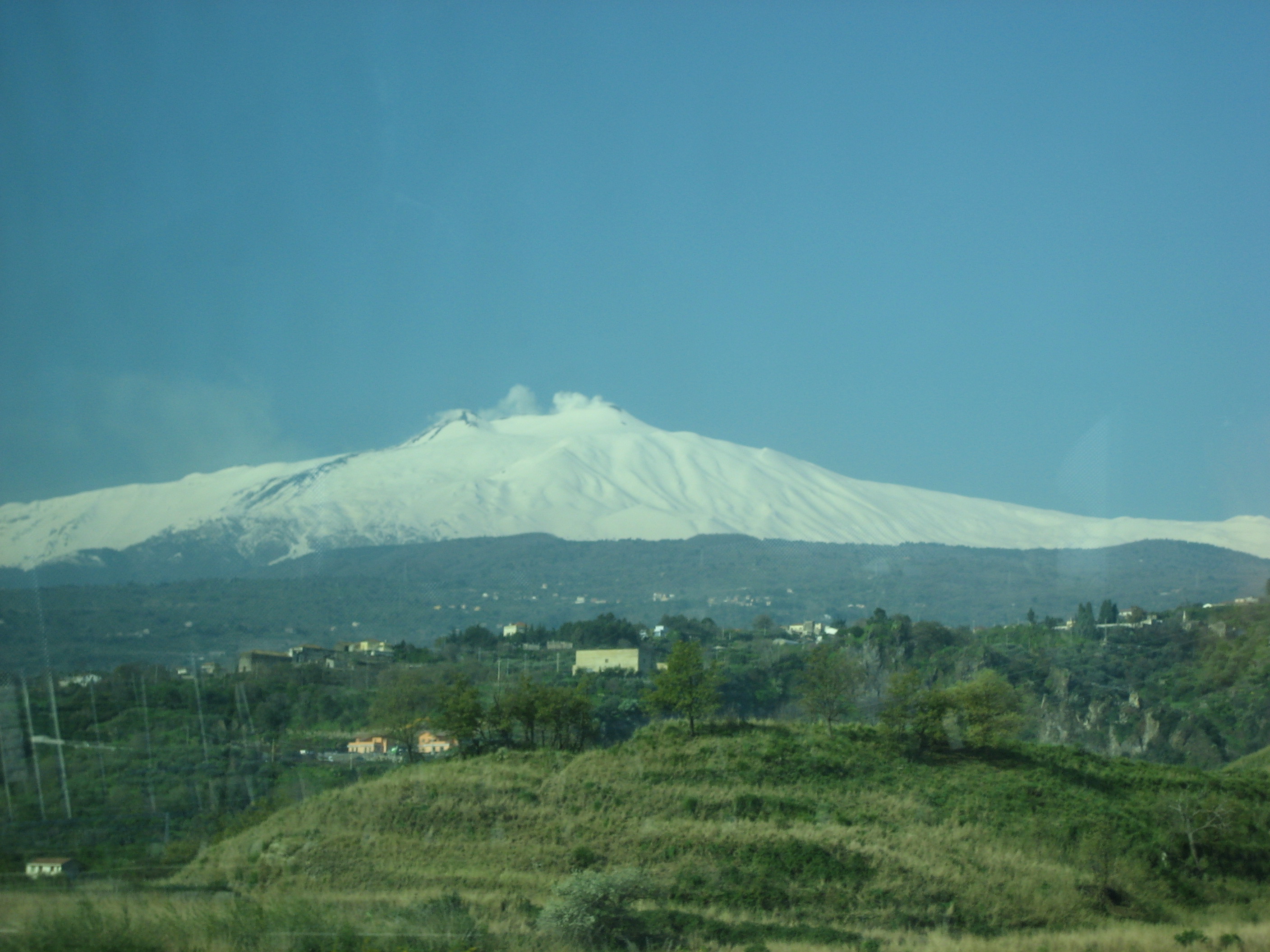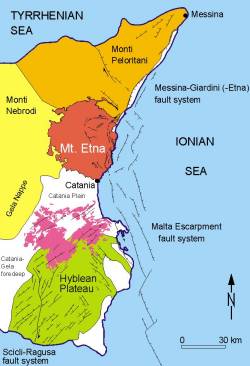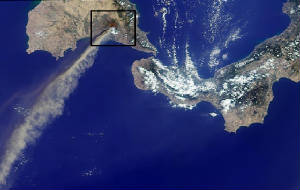|
Mount Etna is situated on the east cost of Sicily in a city by the name of Catania which is Sicily's second largest city.
It is found on the Mediterranean Belt which is "The second common area of active volcanism" (Manroe, Stewart James, pp.
115, para. 1).

|
| copyright Nadia Pagliarello 2007 |
The Valle del Bove
A couple thousand years ago Mount Etna had a devastating
collapses in the east side of the volcano (Behncke, Boris, para. 1). This suggests that the eastern side of the volcano slid
downwards like an avalanche causing the rock to cover everything in its path (Behncke, Boris, para. 1). A depression was then
created on this side of the volcano and was called The Valle del Bove (Valley of
the oxen) (Behncke, Boris, para. 1). At the moment around 80-90 per cent of the Valle del Bove is covered by lavas that were
from eruptions in the 20th century (Behncke, Boris, para. 1). This makes it one of the most hostile and least reachable
areas on Mount Etna (Behncke, Boris, para. 1).This was not always the case with the valley- see Valle del Bove in Interesting
Facts.
The name is still a mystery but the Valle del Bove is a great
source for most of Etna`s evolution and geological importance (Parente, Anthony, para. 4). Many researchers have studied this
part of Etna and have been able to recreate some of the events that have happened during Mount Etna`s long history.
Geological Significance of Mount Etna

|
| Source: http://www.vulcanoetna.it/en_geologia.php |
Volcano
Mount Etna is between a Shield Volcano and a Stratovolcano (Volcano World, sec, 1, para. 3). A Shield Volcano is built
from outpourings of fluid lava flows, while Stratovolcano's are built from layers of lavas, ash and volcanic debris.
This can be confirmed by Etna having pyroclastic eruptions (send ash and rock particles) near the summit of the volcano.
Eruptions
Mount Etna's eruptions can be classified in three different ways : 1) subterminal effusions which take place at the central
cone vent (NASA, para. 3) but now divided into two main craters (see Summit Craters), 2) lateral eruption including venting
of ash at the central cone with the eruption by the volcano flanks as lava pours through the a radial fissure (NASA,
para. 3), 3) lastly, Eccentric eruptions are conrtolled by a noncentral vent (NASA, para. 3) that breaks on
the flank and creates numerous pyroclastic centres along a fissure (Ollier, Cliff, pp. 8).
- When a volcano is of high altitude, it needs a large amount of pressure in order for the lava to reach the summit. Therefore
in some cases the lava finds an easier way to the surface and erupts on the flanks of the main volcano (Ollier, Cliff, pp.
31). After that eruption the lava solidifies and thus for the next eruption another opening must be made (Ollier, Cliff, pp.
31). These openings are called pyroclastic cones (also called adventive cones and secondary cones). Since Mount
Etna is a large volcano it is covered in over 200 pyroclastic cones.
Summit Craters and Cones
Craters on a volcano are a "basinlike depression over a vent at the summit of the cone" (Plummer, pp. 188). Etna's
summit crater is now divided into two main craters by the name of Bocca Nuova and Voragine, the NE and SE craters (Volcano
Etna, para. 13). The NE crater formed in 1911 and the SE crater formed in 1971. These craters are rather new and were
considered subterminal vents (Volcano Etna, para. 13).
Etna's flank cone craters resemble a horse-shoe (Behncke, Boris, para. 6). They open on a downwards slope.
Flank cones on Mount Etna: (Behncke, Boris, para. 7)
- Monte Barca, flank cones near Bronte.
- Monte Moio, Etna's most remote flank cone.
- Monti Rossi, the cone of the 1669 eruption.
- Monte Silvestri, Monti Calcarazzi and Montagnola. The middle of the southern flank of Etna.
- Monte De Fiore, cones of the 1974 eruption
Lavas
Mount Etna's lava comes from sources in the upper mantle (NASA, para. 1) since it has low Sr (Strontium). Lavas conquer
on the lower slopes whereas pyroclastics are seen more near the summit (NASA, para. 3). Pyroclastics are explosive eruptions
that cause early-formed minerals and ash to blow in the air and as they fall to the ground, they weld together while still
hot. Most of Mount Etna's magma is mafic, which explain the large amount of basaltic rock found on the volcano. Mafic rock
is composed of 50% SiO2 and it rich in magnesium and iron.
Geological Setting
Much of Mount Etna's geological
setting remains a mystery (BBC, complicated mountain, para. 2). Etna does not fit any of the concepts of plate tectonics (Behncke,
Boris, tectonic setting and geological evolution). This includes subduction, rifting and hot-spots. Although, BBC indicates
that Mount Etna sometime behaves like a Hot-spot. This is where molten rock comes up from the mantle plumes which derive
from deep within the earth. Sometimes Mount Etna acts like an Island-arc. This is when magma is made due to
tectonic plates sliding past each other (Transform boundary) (BBC, complicated mountain, para. 3).
| Regional Picture of Mount Etna |

|
| Source: http://www.geo.vu.nl/users/wijj/slide%20shows/etna-full.jpg |
Etna Phases
The first eruptions of Mount Etna began during the 'Pre-Etna' (Etnean) phase. At this point Mount Etna was considered
a submarine volcano (King, Russel, pp 161). This explains the pillow lavas found around Mount Etna (King, Russel, pp.
161). Additionally, many towns near by contain these pillow lavas. Pillow lavas are formed when the basaltic lava cools
under water forming ophiolites. Although Mount Etna is no long considered a submarine volcano, it is believe that this phase
took more then half of Etna's history of volcanism (Behncke, Boris, sec. 2).
There are three more phases following 'Pre-Etna'. They are 'Ancient Etna', 'Trifoglietto II' and what Mount Etna is currently
in at this moment "Mongibello'. Throughout these phases Mount Etna has evolved as how we see it today.
|

